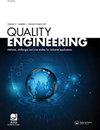致质量工程编辑的信
IF 1.3
4区 工程技术
Q4 ENGINEERING, INDUSTRIAL
引用次数: 0
摘要
我饶有兴趣地阅读了上面的论文,这是一篇系统的文献综述,其声明的目标是“评估Gauge R&R[测量评估]研究的最新状况”。考虑到这个目标,我感到失望的是,回顾论文甚至没有提到对传统设计和规范R&R测量评估研究的分析的任何以下提出的改进。这包括所谓的增强评估计划,利用基线数据,并使用基线杠杆为度量研究选择部分(Browne 2009a,b;Browne et al. 2009a,b, 2010;Stevens et al. 2010, 2013, 2015)。这些想法在不增加成本的情况下提供了更有效的测量评估研究。因此,它们应该被视为对传统Gauge R&R研究的理想改进。为了做一个简单的比较,考虑传统的Gauge R&R研究,从生产过程中随机选择10个零件,每个零件测量6次(这里我们假设一个自动化的测量系统,所以我们不考虑操作员)。如果我们还假设我们有一个曾经测量过的部分的大基线(通常是免费的,因为这些数据通常是出于其他原因收集的),一个替代的测量评估计划是使用杠杆,并从基线中选择10个具有或大或小值的部分,并分别测量它们6次。比较这两个计划(在评估研究中需要相同数量的总度量),我们看到杠杆计划(考虑到所选部件的基线值)比传统的度量R&R计划更有效。对于测量变化与总体变化之比,估计量的标准差降低约在10-45%之间,当实际测量变化较大时,降低幅度更大。本文章由计算机程序翻译,如有差异,请以英文原文为准。
Letter to the quality engineering editor
Comment on the Gauge R&R Literature Review by Soares et al. (2022) I read with interest the above paper that was a systematic literature review whose stated aim was “to assess the state of the art in Gauge R&R [measurement assessment] studies.” Given that goal, I was disappointed that the review paper failed to even mention any of the following proposed improvements to the traditional design and analysis of gauge R&R measurement assessment studies. This includes, so called, augmented assessment plans, utilizing baseline data, and selecting parts for the measurement study using leveraging from the baseline (Browne 2009a,b; Browne et al. 2009a,b, 2010; Stevens et al. 2010, 2013, 2015). These ideas provide much more efficient measurement assessment studies with no increase in cost. As such, they should be considered as desirable improvements to the traditional Gauge R&R studies. To make a simple comparison, consider the traditional Gauge R&R study where 10 parts are selected at random from the production process and measured 6 times each (here we assume an automated measurement system, so we don’t consider operators). If we also assume we have a large baseline of once measured parts (commonly freely available since these data are often collected for some other reason), an alternate measurement assessment plan is to use leveraging and select 10 parts with either large or small values from the baseline and measure them each 6 times. Comparing these two plans (that require the same number of total measurements in the assessment study) we see that the leveraged plan (that takes into account the baseline values for the selected parts) is much more efficient than the traditional gauge R&R plan. The reduction in standard deviation of an estimator for the ratio of the measurement variation to the overall variation is between about 10–45%, with larger reductions when the actual measurement variation is larger.
求助全文
通过发布文献求助,成功后即可免费获取论文全文。
去求助
来源期刊

Quality Engineering
ENGINEERING, INDUSTRIAL-STATISTICS & PROBABILITY
CiteScore
3.90
自引率
10.00%
发文量
52
审稿时长
>12 weeks
期刊介绍:
Quality Engineering aims to promote a rich exchange among the quality engineering community by publishing papers that describe new engineering methods ready for immediate industrial application or examples of techniques uniquely employed.
You are invited to submit manuscripts and application experiences that explore:
Experimental engineering design and analysis
Measurement system analysis in engineering
Engineering process modelling
Product and process optimization in engineering
Quality control and process monitoring in engineering
Engineering regression
Reliability in engineering
Response surface methodology in engineering
Robust engineering parameter design
Six Sigma method enhancement in engineering
Statistical engineering
Engineering test and evaluation techniques.
 求助内容:
求助内容: 应助结果提醒方式:
应助结果提醒方式:


